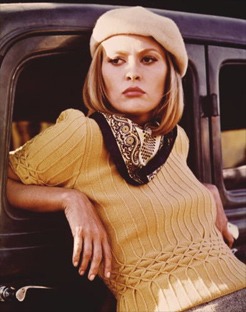Do you ever feel like your tank is empty? You burn fuel at work, taking care of family, worrying about money, dealing with health issues and sometimes, just getting through the day. The last thing you want to see when you finally sit down and turn on the TV is yet another bro-centric adventure movie. You know the type. The climax boasts a rousing chase scene in which the leading lady trips and sprains her ankle. To avoid running on empty, fill your tank with some of these women in films who stick to their guns, make decisions and keep their ankles strong. Begin fueling!
Women in films from the 1960s:
By 1948, the Hollywood Studio System was over. The courts ordered studio owners to sell off their movie theatres, ending their stranglehold on the industry. The studios no longer ‘owned’ their stars and actors were free to work wherever they wanted. That opened the industry to new ideas and new people. At the same time, the House Un-American Activities Committee began its witch hunt, blacklisting and jailing those actors, writers, and directors who refused to name names. By the 1960s, the blacklisted filmmakers could begin to work again, and the studios felt a bit less stifling.
With tsar-like studio heads forced to cede some power and new ideas finding footholds, independent and foreign films began to play in US movie houses. That spirit rubbed off on the big studios, which began to look for fresh faces. Don’t get the wrong idea. Movies still had to turn a profit, so it wasn’t a complete free-for-all, but some independent voices did rise above the chatter. Some of those voices belonged to women.
Here are a few films from the 1960s with strong women characters.
A Raisin in the Sun (1961)
The Youngers, a Black family living in the South Side of Chicago after World War II, have a dream. Their dream is to leave their tiny city apartment and move to a house in the suburbs. Lena Younger (Claudia McNeil), the matriarch of the family wants to use $10,000 in insurance money to buy a house in the all-white, Clybourne Park. There, her children and grandchild will have better lives and she will fulfill her deceased husband’s wish. Her children, Walter (Sidney Poitier) and Beneatha (Diana Sands) have other ideas. Walter wants to buy a liquor store and Beneatha wants to use the insurance to pay for medical school. As the family, including Ruby Dee as Walter’s wife, Ruth, struggle with their decision, external and internal forces seem to work against them.
Lorraine Hansberry wrote the original play and the screenplay, basing parts of it on Hansberry vs Lee, a Supreme Court case in which Hansberry’s father successfully sued a homeowners’ association for attempting to prohibit Black people from buying homes in a middle-class Chicago suburb.
Why should women watch?
Claudia McNeil is a force in this film. She’s loving and nurturing toward her family while standing up for herself and her values. She understands this is a turning point in the lives of her children, but has the fortitude to speak her piece, then stand back and let them fail or succeed on their own. Ruby Dee is always a joy to watch, and Diana Sands is a wonderful presence we lost too soon. Also, Sidney Poitier was looking darn good in 1961.
To Kill a Mockingbird (1962)
Harper Lee’s tale of a principled country lawyer defending a Black man against a spurious charge still resonates. Gregory Peck stars as Atticus Finch, a widower and father of two, who does the honorable thing because it is honorable. Peck is wonderful and believable as a virtuous attorney and a father teaching his children how to think for themselves. His young daughter, Scout, narrates the film as an adult looking back. The character’s grasp of an ugly situation and her essential goodness are extraordinary.
Why should women watch?
The story tells brutal truths, but it is also filled with nobility and light. Scout is fun to watch. She’s a wise person in the body of an elementary school tomboy. Her unfiltered honesty is refreshing. While many of the adults are ignorant and bigoted, the children know what’s right. At the end of the film, you feel like there’s hope for the future.

Bonnie and Clyde (1967)
The story of the Barrow gang, bank robbers who zig-zagged the Depression-era South, stealing and killing, gets a stylish and bloody restructuring under the direction of Arthur Penn. Warren Beatty is Clyde Barrow, a less-than-successful criminal who, along with Faye Dunaway (Bonnie Parker), rob and murder their way to folk hero status. The film was part of a new wave of films that broke firmly established Hollywood rules regarding sex and violence. For one thing, Dunaway was Beatty’s partner, in love and in crime. They were equals. She participated in all the gang’s robberies. She was living with him without the benefit of marriage and even initiated sex! The film also made bank robbery look sexy. Dunaway’s wardrobe, by Theodora Van Runkle, is stellar and Beatty is movie-star gorgeous.
Though it wasn’t the first film to portray the criminals as the good guys, Bonnie and Clyde was a violently anti-establishment film. And it came out during a time when studio heads weren’t quite sure what to do with anti-establishment films. It was a box office hit and a major influence on future films.
Why should women watch?
Faye Dunaway is terrific as the strong-willed Bonnie Parker and she’s at the height of her glamorous period. It’s an action-packed film shot beautifully and if you like stylized crime films, you’ll love it. It’s gory though, so avoid it if blood isn’t your thing. Estelle Parsons won the Oscar for Best Supporting Actress, playing Blanche Barrow, the wife of Clyde’s brother, Buck (Gene Hackman). Look for Gene Wilder in his first film role.
Bonus examples of strong women in films:
- West Side Story (1961)
- The Miracle Worker (1962)
- Mary Poppins (1964)
- The Sound of Music (1965)
- Funny Girl (1968)
The 1970s:
The 1970s wasn’t all avocado princess phones and huge lapels. It was also a great decade for women in film. Pam Grier fought drug dealers in Coffy (1973), Jill Clayburgh established her independence in An Unmarried Woman (1978), and Tatum O’Neal played both a nervy grifter in Paper Moon (1973) and a baseball pitcher on an all-boys team in The Bad News Bears (1976). Cicely Tyson emerged as a dramatic powerhouse, and there were even a few TV shows with female leads. Jodie Foster, who had a few small roles in the 60s, went on a tear in the 70s playing a smartass kid, a prostitute, a murderer, and another smartass kid (ok, a few smartass kids).
Anyway, actresses could choose from a richer array of roles in the 70s than ever before. Here are a few you might want to check out.
Alice Doesn’t Live Here Anymore (1974)
Alice (Ellen Burstyn) leads a typical stay-at-home wife and mother life, until she loses her husband and must fend for herself. With her obnoxiously precocious kid in tow, she sets out to pursue her dream to become a professional singer in Monterey, California. Mom and son live in motel rooms while she gets and loses jobs, until they stop in Tucson, Arizona and Alice gets a job as a waitress at Mel & Ruby’s Diner. There she meets Kris Kristofferson and an assorted bunch of oddballs and contemplates her future.
Why should women watch?
Alice starts out as a doormat and slowly gains confidence and a better sense of herself as she and her son head west. By the end of the film, she realizes she can live life on her own terms. Burstyn won the Oscar for best actress in a leading role for playing Alice. Who directed this feminist film? Martin Scorsese directed with nary a mob boss in sight. Another strong actress with a small, but meaty part, is Jodie Foster. She was 12 at the time and only two years away from her role as Iris, the teenage prostitute in Taxi Driver.
Alien (1979)
Few heroines attain the level of badassery Ripley (Sigourney Weaver) does in Ridley Scott’s Alien. After a team of space miners receives a distress call, they drop anchor on a seemingly uninhabited planet. The planet turns out to be more inhabited than they thought. After an incident on the surface, Ripley warns the crew not to allow a potentially contaminated crew member back on the ship. Hint: They should have listened.
Why should women watch?
Ripley is a smart, strong leader in a terrifying situation. She’s decisive and she thinks logically. Ripley’s character and Weaver’s portrayal of her is a refreshing change from science fiction films of the past when the men fought the evil space mollusk while the lone woman crew member (with a Ph.D.) stayed in the space capsule to tidy up. Alien is a tense action-filled thriller with a brave, resourceful, female protagonist.
Norma Rae (1979)
Sally Field won an Oscar for her portrayal of a poor southern textile worker who teams up with Ron Leibman, a labor organizer, to fight management and unionize the textile mill. She fights ignorance, prejudice, and all the powerful folks in town to make the mill a better, more humane place to work. It’s a solid film with a terrific cast of character actors like Gail Strickland, Pat Hingle, Beau Bridges, and Grace Zabriskie.
Why should women watch?
Sally Field launches herself into the role of a woman who lives in a world with few expectations and fewer options, who decides she’s had enough. She works tirelessly to make a better life for herself and her family and learns to value herself as a person. Norma Rae is an exhilarating film.
Bonus examples of strong women in films:
- Sounder (1972)
- The Autobiography of Miss Jane Pittman (1974)
- Paper Moon (1973)
- The Bad News Bears (1976)
- An Unmarried Woman (1978)
- Coming Home (1978)
Are you a fan of older films chock full of powerful, independent women? Check out our earlier article on films from the 30s, 40s and 50s.







Add Comment